preface to the anglo-american cataloguing rules, second edition
preface to the anglo-american cataloguing rules, second edition
preface to the anglo-american cataloguing rules, second edition
Create successful ePaper yourself
Turn your PDF publications into a flip-book with our unique Google optimized e-Paper software.
five participating organizations, and provided for two edi<strong>to</strong>rs, one from ei<strong>the</strong>r side of <strong>the</strong>Atlantic. JSCAACR’s function has been <strong>to</strong> appoint <strong>the</strong> edi<strong>to</strong>rs, <strong>to</strong> consider all proposalsand determine questions of policy with <strong>the</strong> edi<strong>to</strong>rs, <strong>to</strong> assess for approval <strong>the</strong> <strong>rules</strong> framedby <strong>the</strong> edi<strong>to</strong>rs, and <strong>to</strong> present <strong>the</strong> final text for publication; and thus <strong>to</strong> be <strong>the</strong> ultimateauthority for <strong>the</strong> content and presentation of this <strong>second</strong> <strong>edition</strong>.An early result of JSCAACR’s consideration of <strong>the</strong> objectives and its own terms ofreference was its declaration of <strong>the</strong> guidelines by which policy questions and newproposals were <strong>to</strong> be determined. These guidelines were stated publicly at <strong>the</strong>commencement of <strong>the</strong> project; <strong>the</strong>y have been sustained throughout <strong>the</strong> two and a halfyears of its completion, and <strong>the</strong>y may be summarized as follows:1) maintenance of general conformity with <strong>the</strong> Paris Principles of 1961, as manifested in<strong>the</strong> first <strong>edition</strong>2) particular attention <strong>to</strong> developments in <strong>the</strong> machine processing of bibliographicrecords3) continuance of conformity with <strong>the</strong> ISBD(M) as a basis for <strong>the</strong> bibliographicdescription of monographs, and commitment <strong>to</strong> <strong>the</strong> principle of standardization in <strong>the</strong>bibliographic description of all types of materials4) determination of <strong>the</strong> treatment of nonbook materials primarily from a consideration of<strong>the</strong> published <strong>cataloguing</strong> <strong>rules</strong> of <strong>the</strong> Canadian Library Association, <strong>the</strong> LibraryAssociation, and <strong>the</strong> Association for Educational Communications and Technology;and of <strong>the</strong> ALA revision of chapter 12 of <strong>the</strong> 1967 text. 1With regard <strong>to</strong> <strong>the</strong> first of <strong>the</strong> guidelines, <strong>the</strong> <strong>second</strong> <strong>edition</strong> continues <strong>to</strong> reflect <strong>the</strong>tendency <strong>to</strong> closer conformity with <strong>the</strong> Paris Principles that was already embodied inamendments <strong>to</strong> <strong>the</strong> 1967 texts promulgated before work on <strong>the</strong> <strong>edition</strong> began, specifically<strong>the</strong> abandonment of entry under <strong>the</strong> name of a place of certain institutional bodies, asrelated <strong>to</strong> section 9.4 of <strong>the</strong> Paris Principles 2 ; and some o<strong>the</strong>r shortfalls in conformityhave been made good during <strong>the</strong> course of approving new proposals, notably by <strong>the</strong>substitution of uniform titles for form subheadings in relation <strong>to</strong> section 9.5.With regard <strong>to</strong> <strong>the</strong> <strong>second</strong> guideline, <strong>the</strong> single most important contribution of this <strong>edition</strong><strong>to</strong> meeting <strong>the</strong> needs of machine processing resides, in <strong>the</strong> submission of <strong>the</strong> authors, in<strong>the</strong> achievement of an integrated and standardized framework for <strong>the</strong> systematicdescription of all library materials, as presented by part I. This achievement, being also<strong>the</strong> first such comprehensive systematization <strong>to</strong> be related <strong>to</strong> <strong>the</strong> goals of internationalstandardization, is also presented by <strong>the</strong> authors as <strong>the</strong> principal fulfilment of <strong>the</strong>undertaking (in objective 4 above) <strong>to</strong> make a contribution <strong>to</strong> <strong>the</strong> development of aninternational <strong>cataloguing</strong> code, and as a major development in its own right.It is also <strong>the</strong> principal means by which <strong>the</strong> third and fourth guidelines have beensustained, and by which resolution has been achieved of <strong>the</strong> conflict that was soon1 See Sources on page xxx for full citations.2 See <strong>the</strong> Introduction <strong>to</strong> <strong>the</strong> 1967 <strong>edition</strong> of AACR (pp. 2–4 North American text; pp. 2–3 British text)for a summary statement on <strong>the</strong> initial relationship with <strong>the</strong> Paris Principles; and Statement of Principles …Paris … 1961. Annotated Edition (full citation at Sources, below, p. xxx) for an extensive commentary withtexts of <strong>the</strong> Principles.





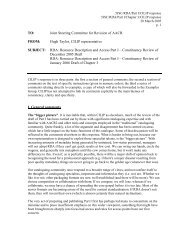
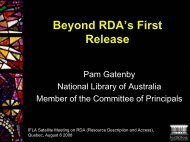

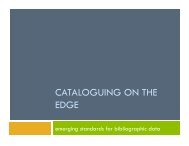

![Presentation slides [PDF] - Joint Steering Committee for ...](https://img.yumpu.com/41621230/1/190x143/presentation-slides-pdf-joint-steering-committee-for-.jpg?quality=85)

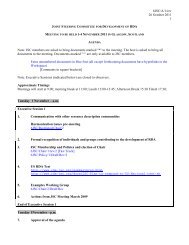
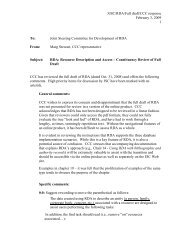
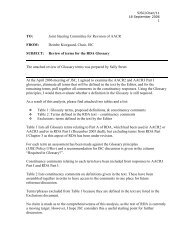
![Presentation slides [PDF] - Joint Steering Committee for ...](https://img.yumpu.com/35256207/1/190x143/presentation-slides-pdf-joint-steering-committee-for-.jpg?quality=85)
